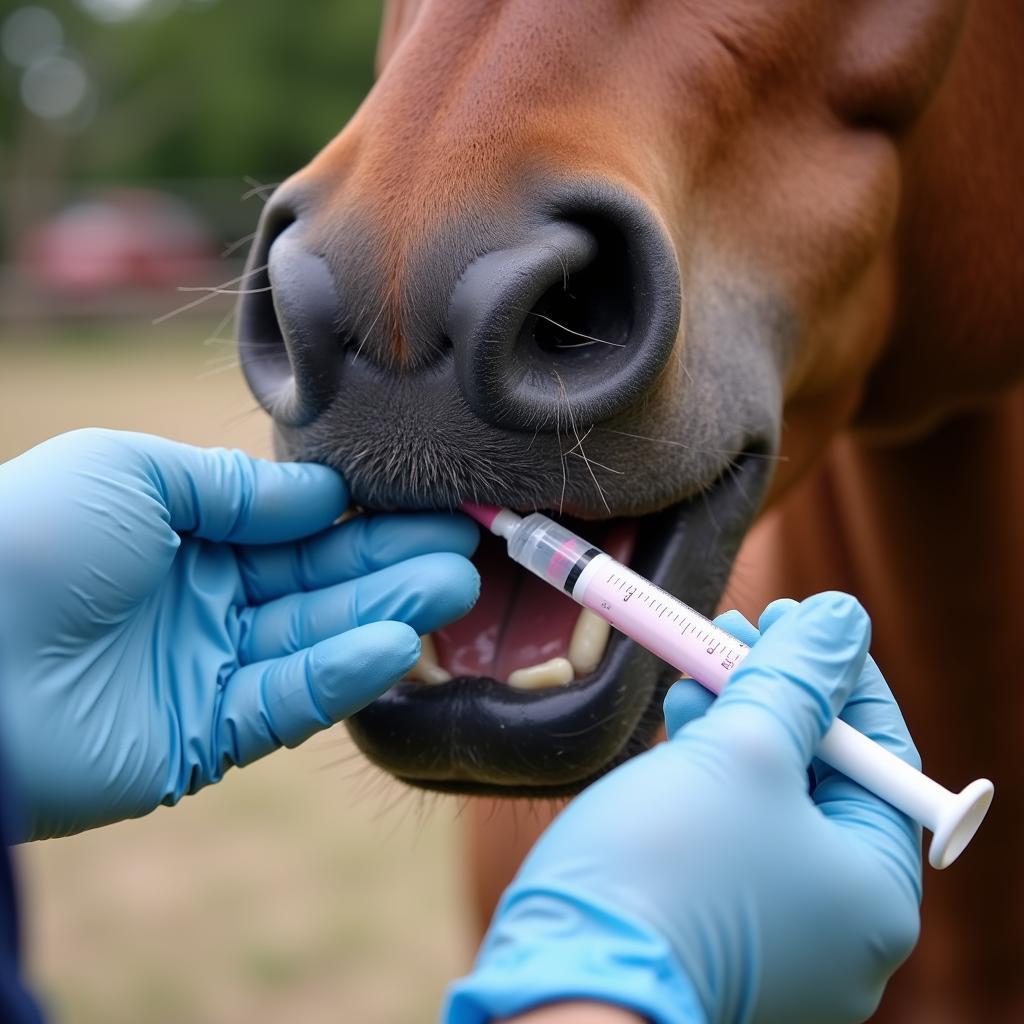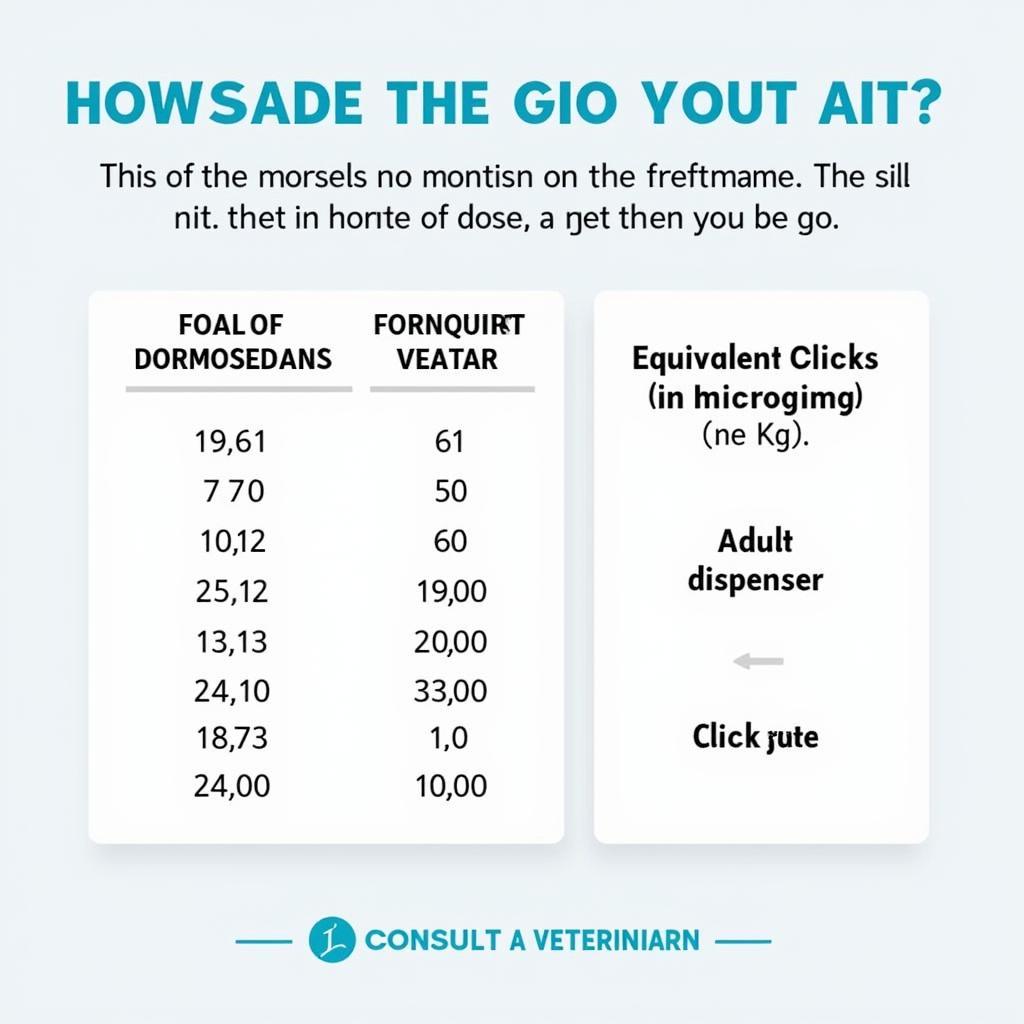Dormosedan gel is a commonly used sedative for horses, but administering the correct dosage is crucial for both safety and effectiveness. Understanding the factors that influence dosage, potential side effects, and proper administration techniques will ensure the well-being of your horse.
Understanding Dormosedan Gel
Dormosedan gel, containing the active ingredient detomidine hydrochloride, provides reliable sedation in horses. It’s favored for its ease of administration and relatively quick onset of action. This makes it suitable for various procedures, from routine dental work to minor surgical interventions. However, it’s important to consult with a veterinarian to determine the appropriate dormosedan gel dosage for your horse’s specific needs.
Factors Influencing Dormosedan Gel Dosage
Several factors contribute to the appropriate dormosedan gel dosage for an individual horse. These include:
- Weight: This is the most critical factor. Dosage is calculated based on the horse’s weight in kilograms.
- Age: Older horses and very young foals may require dosage adjustments.
- Temperament: A particularly anxious horse might need a slightly higher dose, while a calmer horse might require less.
- Procedure: The level of sedation required varies depending on the procedure being performed.
- Health Status: Pre-existing medical conditions can influence the appropriate dosage.
 Administering Dormosedan Gel to a Horse
Administering Dormosedan Gel to a Horse
Calculating the Correct Dormosedan Gel Dosage
While your veterinarian will provide the precise dosage for your horse, a general guideline is 20 micrograms of detomidine hydrochloride per kilogram of body weight. This translates to one “click” of the standard Dormosedan gel dispenser for every 100 kg of body weight. However, it is crucial to consult with your veterinarian before administering any medication to your horse.
Administering Dormosedan Gel
Dormosedan gel is administered orally, typically by placing it on the mucous membranes of the horse’s mouth. It’s essential to follow these steps:
- Ensure the horse is restrained appropriately.
- Wear gloves to avoid accidental exposure.
- Remove the cap from the Dormosedan gel dispenser.
- Place the tip of the dispenser against the horse’s inner cheek or on the tongue.
- Depress the plunger to deliver the prescribed number of clicks.
- Hold the horse’s head up for a few seconds to allow the gel to absorb.
 Dormosedan Gel Dosage Chart for Horses
Dormosedan Gel Dosage Chart for Horses
Potential Side Effects of Dormosedan Gel
While Dormosedan gel is generally safe, some horses may experience side effects, such as:
- Decreased heart rate
- Lowered blood pressure
- Ataxia (incoordination)
- Sweating
These side effects are usually transient and resolve as the sedative wears off. However, if you observe any unusual or concerning symptoms, contact your veterinarian immediately.
When to Call Your Veterinarian
Dormosedan gel is a valuable tool for managing horses during various procedures. However, it’s crucial to work closely with your veterinarian. You should contact your veterinarian immediately if:
- You are unsure about the correct dosage.
- Your horse experiences any adverse reactions.
- The desired level of sedation is not achieved.
- You have any questions or concerns regarding the use of Dormosedan gel.
Conclusion
Dormosedan gel is a useful sedative for horses, but proper dosage and administration are essential. Always consult with your veterinarian for guidance on the correct dosage for your horse’s individual needs and health status. Following their instructions carefully will help ensure the safety and well-being of your equine companion. Don’t hesitate to reach out to your veterinarian if you have any questions about Dormosedan gel or its usage.
FAQ
- How long does it take for Dormosedan gel to take effect?
- Can Dormosedan gel be used in pregnant mares?
- What are the signs of an overdose of Dormosedan gel?
- Are there any medications that should not be used with Dormosedan gel?
- How long does the sedation from Dormosedan gel typically last?
- Can Dormosedan gel be used in conjunction with other sedatives?
- What should I do if my horse accidentally ingests more Dormosedan gel than prescribed?
Dormosedan Gel Dosage Scenarios
- Routine Dental Procedures: A standard dose is typically sufficient for routine dental floats.
- Minor Laceration Repair: Depending on the horse’s temperament, a slightly higher dose might be needed.
- Pre-Transportation Sedation: A lower dose can help reduce stress during transport.
Related Articles
- Understanding Equine Sedation
- Common Equine Medications
- Horse Health and Wellness
If you need further assistance, please contact us at Phone Number: 0772127271, Email: [email protected] Or visit us at: QGM2+WX2, Vị Trung, Vị Thuỷ, Hậu Giang, Việt Nam. We have a 24/7 customer support team.